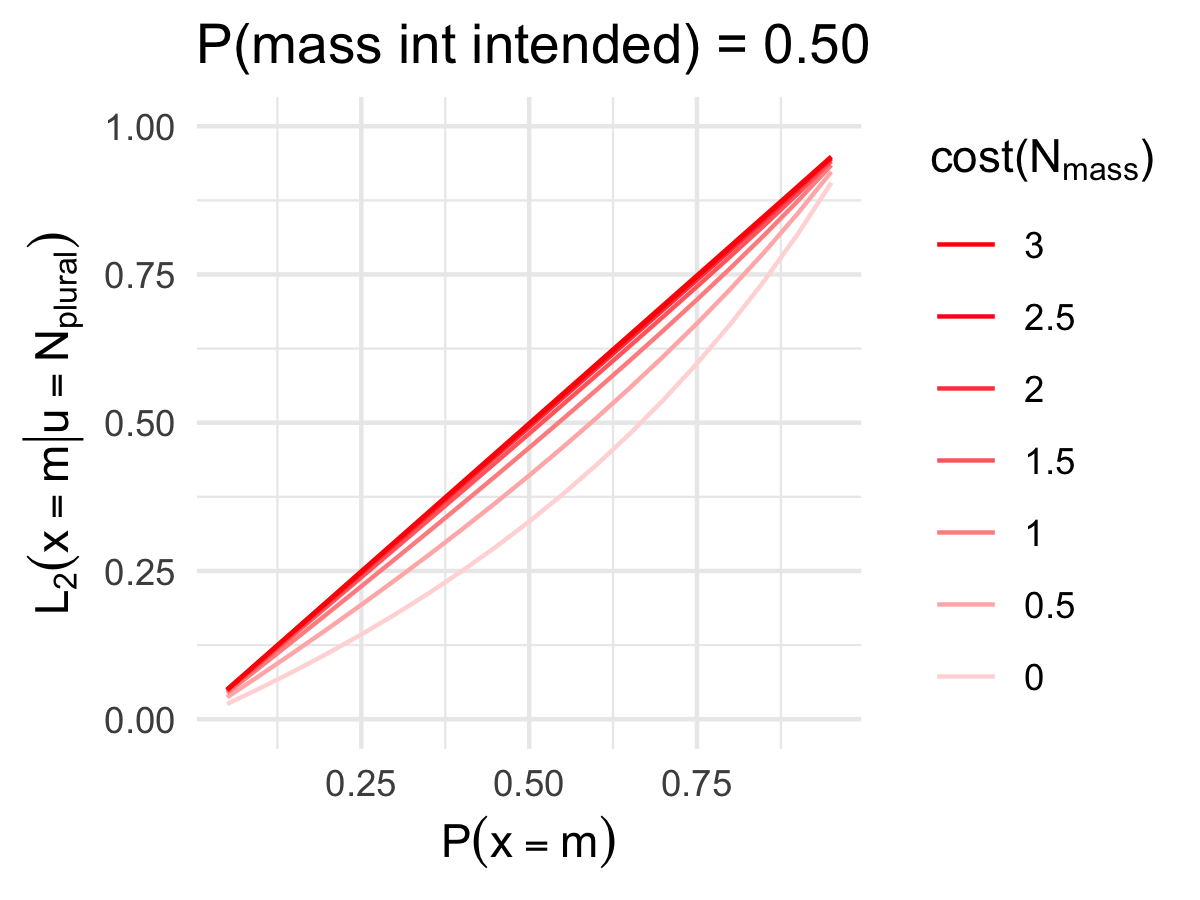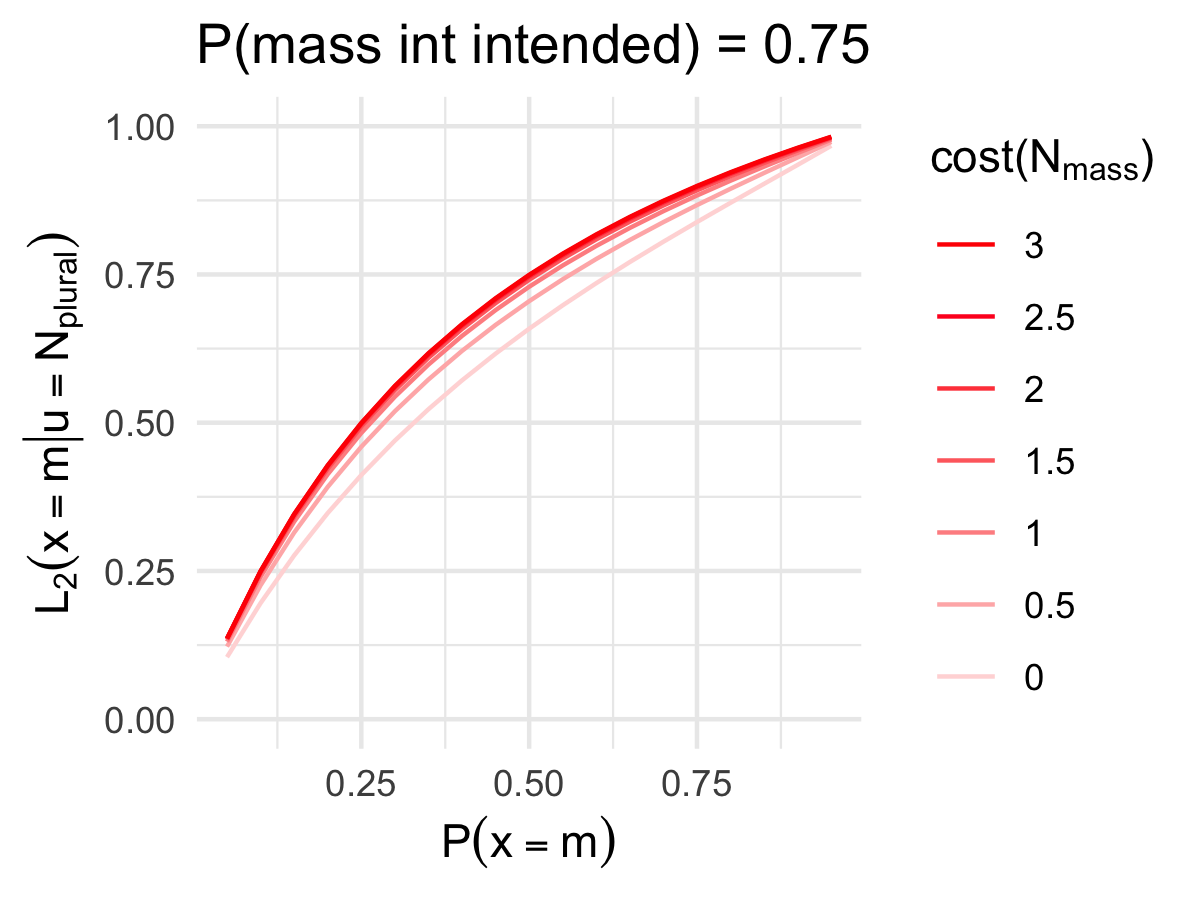The decompositional approach
A common feature of previous formal semantic theories of mass/count is decomposition
Nouns are syntactically decomposed. Roughly:
Ncount =
These sub-components are assigned model-theoretic denotations:
count introduces flexible individuationmass is analysed differently by different theoriesPL -operator (closure under )
Limits of the decompositional approach
Assuming compositionality we want
But this has led to 'generalisation to the most bleached case':
Count universally encodes flexible individuation (due to wall, fence)Mass universally has very weak meaning (due to object mass nouns)
We argue against the decompositional approach based on variation among hybrid nouns (alt. flexible nouns, dual-life nouns) in Midwest American English
Hybrid nouns
Hybrid nouns can be used as mass or count, e.g. stone, rope, apple, chocolate
Mass/count often has a clear interpretative effect for hybrid nouns


E.g., Barner & Snedeker's (2005) Comparative Task (see also Bale & Barner 2018)
(3) Who has more stonemass? ⇢ volume-based comparison
(4) Who has more stonescount? ⇢ number-based comparison
We'll point out that there's more to the semantics of hybrid nouns
Our observations and claims
Key observations: Variety of count hybrid nouns
- Some count hybrid nouns are not so flexible with respect to individuation (e.g. apple)
- Some plural count hybrid nouns are compatible with no individuation (e.g. potatoes)
Proposal: Renounce decomposition in terms of
- Ncount may encode an idiosyncratic manner of individuation ⇒ 1.
- Npl.count and Nmass have trivial interpretations, only if the other one is infrequent ⇒ 2.
Varieties of individuation
Flexible individuation: rope
Ropecount can describe all sorts of perceptually countable instances, similarly to wall
(5) We've got some ropes here.
 |
 |
 |
 |
(6) Let's cut one of the ropes into smaller ropes.
Specific individuation: apple
Applecount can only describe whole apples, not sliced or diced instances
(7) We have some apples here.
 |
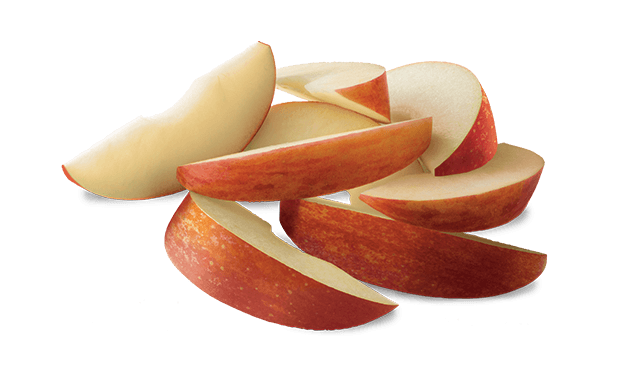 |
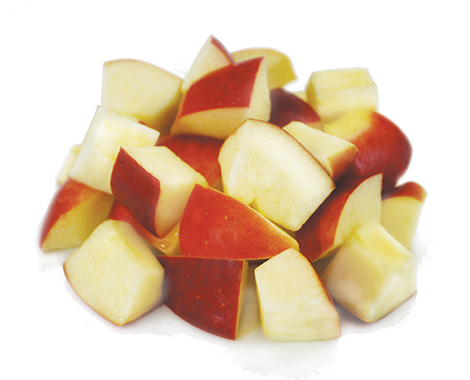 |
 |
 |
 |
 |
 |
(8) #Let's cut one apple into smaller apples.
Specific individuation: chocolate
Chocolatecount can describe a chocolate truffle, but not a bar or an arbitrary piece
(9) I will give you a chocolate.
 |
 |
 |
 |
 |
 |
 |
 |
(10) #Let's break a chocolate into smaller chocolates.
Interim summary
As expected, applecount and chocolatecount cannot describe unindividuated instances
But they also cannot describe arbitrary pieces, even if clearly perceptually individuated
☞ These count nouns encode specific individuation (unlike wall and rope)
- applesg.count
- chocolatesg.count
- wallsg.count
- ropesg.count
(The encoded specific individuation is probably not completely random but can be idiomatic like chocolate)
Plural count hybrid nouns
An apple vs. a potato
A potato is similar to an apple
| (11) I'll give you an apple. | (12) I'll give you a potato. | |||
 |
 |
 |
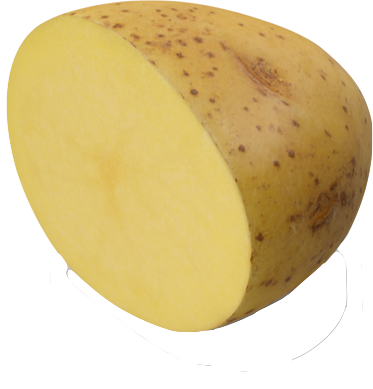 |
|
 |
 |
 |
 |
|
Apples
Given how an apple behaves, apples can be undesrtood in terms of the -operator
(13) I'll give you some apples.
 |
 |
 |
 |
 |
 |
 |
 |
(14) Who ate more apples? ⇢ number-based comparison
Potatoes
Potatoes is not simply sums of singular potatoes: potatoespotatosg.count
(14) I'll give you some potatoes.
 |
 |
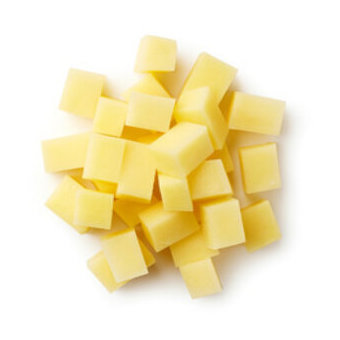 |
 |
 |
 |
 |
 |
(15) Let's cut one of these potatoes into smaller potatoes.
(16) Who ate more potatoes? ⇢ both volume and number comparisons possible
-
Flexible individuation, -plural (rope-class)
rope, paper, brick, wire, cable, string, hair, (sub)sandwich, fibre, oat, plank, board, pipe, steak, talk, meeting, exercise -
Specific individuation, -plural (apple-class)
apple, chocolate, lemon, banana, eggplant, artichoke, hamburger, pizza, cake, beard, chicken, duck, mango, candy, song, show, movie, bone -
Specific individuation, mass-plural (potato-class)
potato, strawberry, carrot, leaf, french fries, chickpea, pea, potato chip, lentil, tomato, noodle, blueberry, pebble -
Flexible individuation, mass-plural (cloud-class)
cloud, wind, detail
Towards an analysis
Key observations
Two observations about count hybrid nouns:
- Specific individuation
Nsg.count may encode a specific manner of individuation (e.g. apple, chocolate)
- Plural count nouns with mass denotations
Npl.count may have a mass-like denotations (e.g. potatoes, clouds)
1. Specific individuation
All singular count nouns encode individuation, but some encode specific manners
☞ A generic individuation function for 'Spelke objects' will be too permissive; a Natural Unit function will be too restrictive
Idea: The interpretation of Nsg.count is not compositionally derived from and
- applecount
- potatocount
- chocolatecount
- wallsg.count
- ropesg.count
2. Plural count nouns with mass denotations
Potatoes can describe all sorts of instances, unlike apples
NB: potatomass is also available
(17) There's some (mashed) potato on your shirt.
Proposal: What differentiates potato and apple is the relative frequency of Nmass
-
Grimm & Wahlang's (2021) corpus data (350 million words) with Allan's (1980) diagnostic for countability
-
Potato is mostly marked count (84.3%) vs. apple (61.4%)
-
10 most skewed hybrid nouns: pickle, dumpling, sprout, carrot, bouquet, leaf, pea, potato, beet, egg
Frequency effects and RSA with Lexical Uncertainty
Idea: When Nmass is relatively infrequent, Nplural.count can be used to mean the same thing
We use a Rational Speech Act (RSA) model with Lexical Uncertainty (Bergen, Levy & Goodman 2016, Scontras & Goodman 2017)
- Npl.count has two potential denotations,
Plural : Nsg.count vs.Mass : Nmass - When Npl.count is used, the listner probabilistically guesses what the intended interpretation is, based on cooperativity
- The relative frequency of Nmass (implemented as speaker cost) and the frequency of intended meaning affect the reasoning
- If Nmass is not costly, cooperative speaker avoids ambiguous Nplural to mean
mass - Details in Appendix
Further directions
- Symmetric frequency effects of mass/count
- If Nmass is infrequent, Nplural can mean the same thing ☞ potatoes
- If Nplural is infrequent, Nmass can mean the same thing ☞ object mass nouns
- We expect cross-linguistic/dialectal variation and language change over time
- Frequencies change for many reasons
- Very specific idiosyncratic meanings of singular count nouns can fail to be acquired
"Spearman, and others [...], carried out many ingenious researches using mental tests and guided by his 'two factor' hypothesis."
(Godfrey Thomson, 1947, "Charles Spearman, 1863–1945", doi.org/10.1098/rsbm.1947.0006)
Summary
Summary
Key observations: Count hybrid nouns show
- Interpretive variation with respec to individuation
- Flexible individuation: rope, string, paper
- Specific indiivduation: apple, chocolate, potato
- Unexpected mass meaning in the plural for some: potatoes, clouds, lentils
Proposal
- Singular count nouns may encode compositionally opaque individuations
- The denotations of plural count nouns are computed via compeition with mass
The observations pose challanges for the traditional decompositional approach
Appendix
RSA with Lexical Uncertainty for plural vs. mass
RSA with Lexical Uncertainty
We assume that Nplural has two potential interpretations,
We implement this ambiguity in terms of a parameter on (Bergen, Levy & Goodman 2016, Scontras & Goodman 2017)
RSA with Lexical Uncertainty
- The literal listner infers what interpretation is intended based on the utterance and a parameter on
- The th speaker picks out the best message for given , relative to
-
Infrequent expressions are more costly
-
The th listener decodes relative to
Simulation
